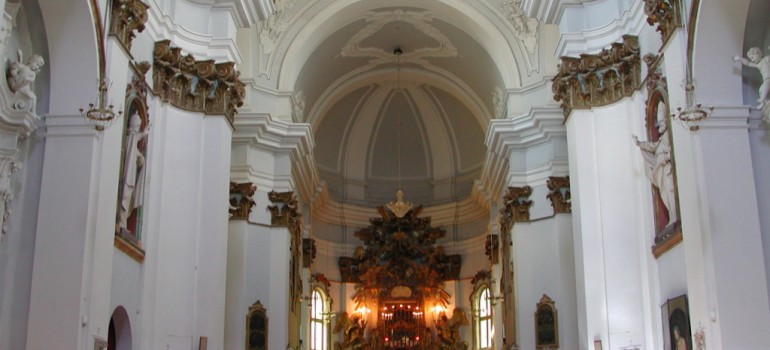
It is a massive brick structure built in the 14th century and located where the small Church of St. Mary Magdalen once stood. The Baroque style of the present structure is the result of many changes undergone by the church over the centuries. The outer side looking onto Piazza Forlini allows the sight of some details of the fourteenth-century church, such as the arch friezes of Romanesque-Gothic style. The dome is octagonal while the bell tower in the rear side is of Byzantine style. Still visible today is the quadrilateral cloister-garth from the sixteenth century which is closed by a parapet of octagonal columns with stone capitals in the middle of which there is a well. The cloister-garth can be entered both through the church and an outer door, since the upper rooms are used as classrooms. The main façade is enriched with a monumental bronze portal by local sculptor Aldo Sergiacomi dating back to 1994, which describes the donation of Longino D’Azzone and the story of the Eucharistic Miracle, besides portraying several saints. The interior of the church has a single nave, a Latin-cross plan and is particularly rich in gold capitals. The side walls host several niches containing statues of the Augustinian Saints and several altars embellished by valuable canvasses. The high marble altar and the via crucis sited on the side walls are by the sculptor Aldo Sergiacomi. Behind the high altar there is the eighteenth-century choir consisting in two rows of seats by the so called “Maestro of the Choirs”. The Chapel of the Eucharistic Miracle can be entered from here. Sited at the back of the apse, the Chapel of the Eucharistic Miracle contains the remaining evidence of a Eucharistic miracle occurred in Lanciano in 1273 which tells the story of Giacomo Stasio and Ricciarella, who, in order to reach some kind of domestic peace, mixed a consecrated host with her husband’s food. The host turned into bleeding strips of flesh. After long ups and down the miracle has been officially recognized. These precious relics, jealously kept inside this church for many years, consist of a thirteenth-century table-cloth, which is unique in its kind, a blood-stained cup and a piece of host turned into flesh and blood. All that is kept inside a fourteenth-century silver cross created by a renowned Venetian goldsmith and are placed inside an aedicule secured by an iron gate and two fifteenth-century walnut shutters. They are to be seen only on Holy Cross Day, 3rd May.
Altri monumenti a Offida
 Lascia un commento
Lascia un commento